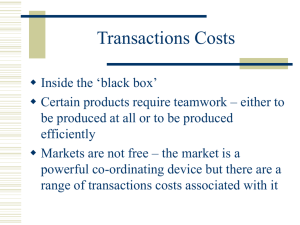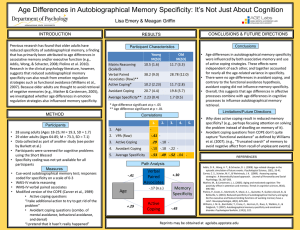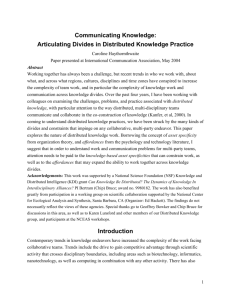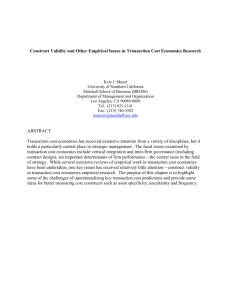Dynamic Adaption in Long-Term Contracts: The Case of US Coal
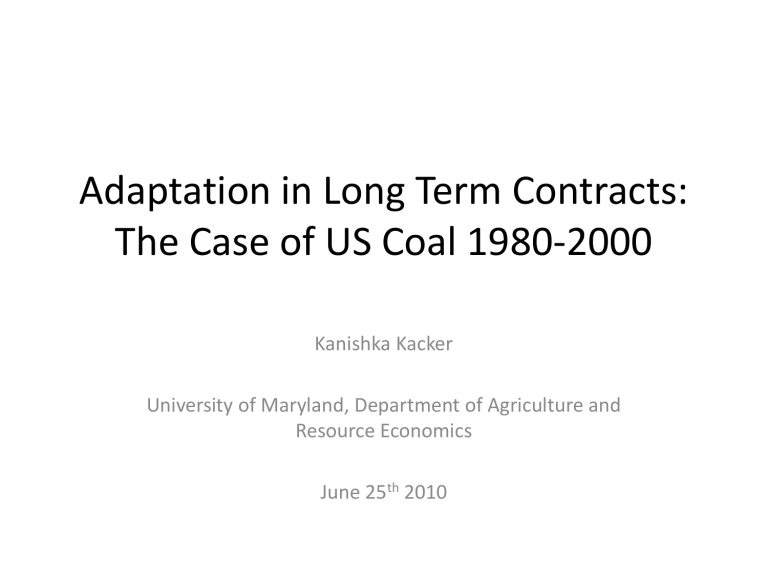
Adaptation in Long Term Contracts:
The Case of US Coal 1980-2000
Kanishka Kacker
University of Maryland, Department of Agriculture and
Resource Economics
June 25 th 2010
Prelude: 2 quotes
• Joskow (1985): “Long-term (nominal) fixed-price contracts are simply not credible in a market like this, and I would not expect them to be used extensively”
• Hart (2009) Proposition 1: “(Price) Indexed contracts are strictly superior to nonindexed
contracts”
• “(This) result is consistent with Joskow’s finding that price indexation is a common feature of contracts between
suppliers and buyers of coal”
These assertions are contradicted
Coal transportation rate database, Energy Information
Administration, USA
In 1980 the dominant contract form specifies a
Base Price with escalation clauses built in …
…In 2000, this is no longer true
Fixed Price contracts account for approx 50% of contracts
Some good questions
• Are these buyers (Power Plants) and sellers (Coal
Mines) being silly?
– Herbert Simon (1951): “Human behaviour is
intendedly rational, but only limitedly so”
• Who cares about coal anyway?
– Wide variation in governance forms at a point in time
(Joskow, 1987)
– Environmental regulation alters governance structure over time underlying motivation
Supplier Side shifts (1)
500 000
450 000
400 000
350 000
300 000
250 000
200 000
150 000
100 000
50 000
0
Production (thousand short tons) (y)
Appalachia
Interior
Western
1986 1991 1994 1997
…production of
Western Mines increases rapidly
Supplier Side Shifts (2)
Number of Mines (n)
4 500
4 000
3 500
3 000
2 500
2 000
1 500
1 000
500
0
1986 1991
Appalachia
1994
Interior Western
1997
…so average mine size increases overall, but the increase for Western mines is massive
350
300
250
200
150
100
50
0
…while the number of mines declines overall,
Appalachian/Interior mines fall by a greater amount…
7 000
6 000
5 000
4 000
3 000
2 000
1 000
0
Average Mine Size (thousand short tons) (= y/n)
1400
1200
1000
800
600
400
200
0
1986
Western
1991 1994
Appalachia
1997
Interior
Demand side shifts
• 1990 Clean Air Act Amendment
– Established permit trading program for Sulfur Di-
Oxide
– Total emissions capped
– Constraint set to bind in 2 phases
• Phase I (begins 1995) targets the dirtiest 110 coalburning power plants
• Phase II (begins 2000) new restrictions on cleaner plants, older restrictions tightened
Why have long term contracts at all?
– Given significant investment in relationship-specific capital, repeated bargaining is unattractive
– Hold-up problem: “Sunk” investments create opportunities for haggling ex-post
• Discourage investment ex-ante
– These opportunities need to be mitigated to allow for
(efficient) trade
– A long term contract is the instrument through which this mitigation is carried out
What determines contractual relations?
• Williamson (1985): governance form varies according to
– Asset Specificity
– Uncertainty
– Frequency
Joskow’s interpretation (1987)
• Contract duration = F (Site Specificity, Physical Asset
specificity, Dedicated Assets)
Site specificity = “Mine-mouth” Power Plants
Physical asset specificity = Boiler specification for different kinds of coal
Dedicated assets = Coal quantity
Joskow interpretation: Williamson theory should predict F
1 inverse U shape
>0, F
2
>0, F
3
This is what he finds
Joskow (1987)
Contract duration =
F ( Site Specificity , Physical
Asset specificity , Dedicated
Assets )
F
1
>0,
“Site
Specificity”
F
2
>0,
F
3 inverse U shape
“Dedicated
Assets”
Physical
Asset
Specificity
Regulation, technology alteration and altered contracts
• Power plant engineers begin to alter boilers to burn
Western coal
• Changing boiler technology asset more generic decreased physical asset specificity lessens incentive to engage in long-term contracts
Revisit earlier model: Does the prediction of declining asset specificity hold up?
• Contract duration = F (Site Specificity, Physical Asset
specificity, Dedicated Assets)
• Want a reduced coefficient for physical asset specificity…
• Will take data from 1990 to 2000, and divide into two time periods 1990 - 1995 and 1995 – 2000
Comparative Static Assessment
Joskow: Mine
A comparative static assessment
• We have evidence of a buyer (power plants) looking to alter a technology to accommodate a changing supplier (coal mine)
=> Following transaction cost theory (Williamson
1985), physical specificity is reduced less incentive to engage in long term contract
• The only assessment allowed by this theory is a comparative static one
How do contracts change as their environment changes?
• Why is this important?
– Examine how contracts work , not “make or buy”
– Klein (2004) talks about examining changes in contractual arrangements to changing circumstances
– “Contracts as reference points” theory predictions flatly contradicted by data on coal contracts
• Most theorizing has taken a static viewpoint
– Che and Sakovics (2004) explicitly talks about a dynamic theory of hold-up
– Admitting dynamics, they find hold-up need not entail underinvestment
• Dynamics of contractual change need to be understood
• Through the effects of regulation on contractual arrangements
Summing up
• Dataset of contracts that capture buyer-seller interaction at a time when both experience significant shifts
• Evidence of altered contractual arrangements in line with a comparative static prediction of transaction cost theory
• Explicit characterization of dynamics underlying contractual shifts (following from regulation) is what is needed
